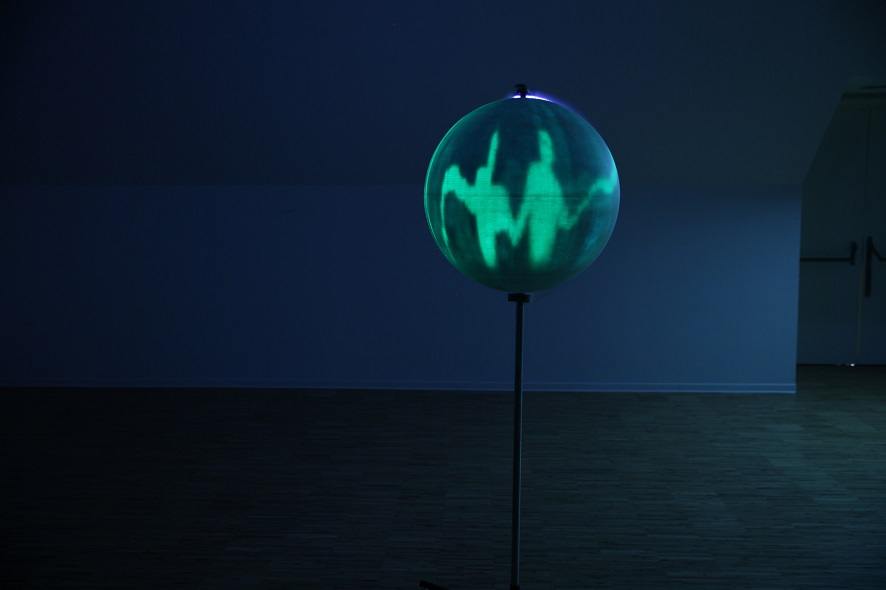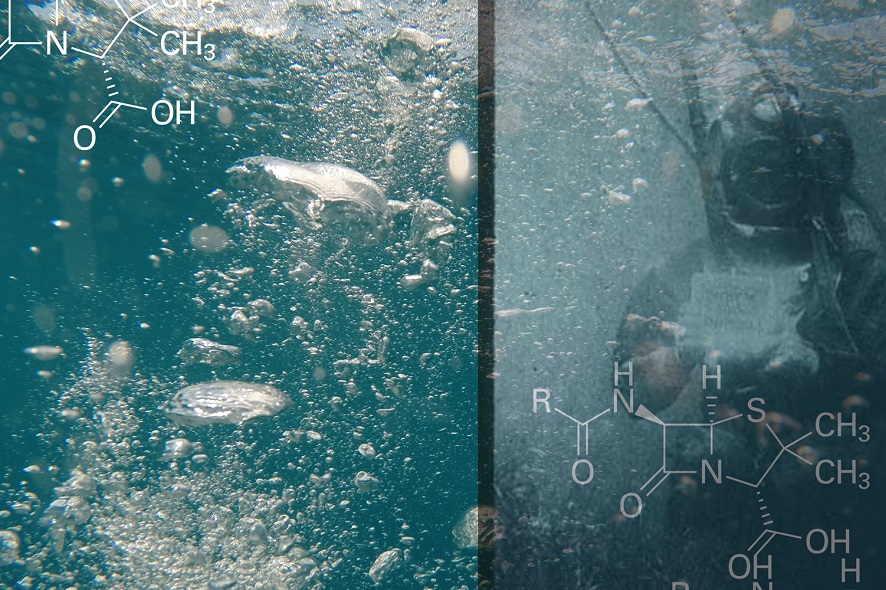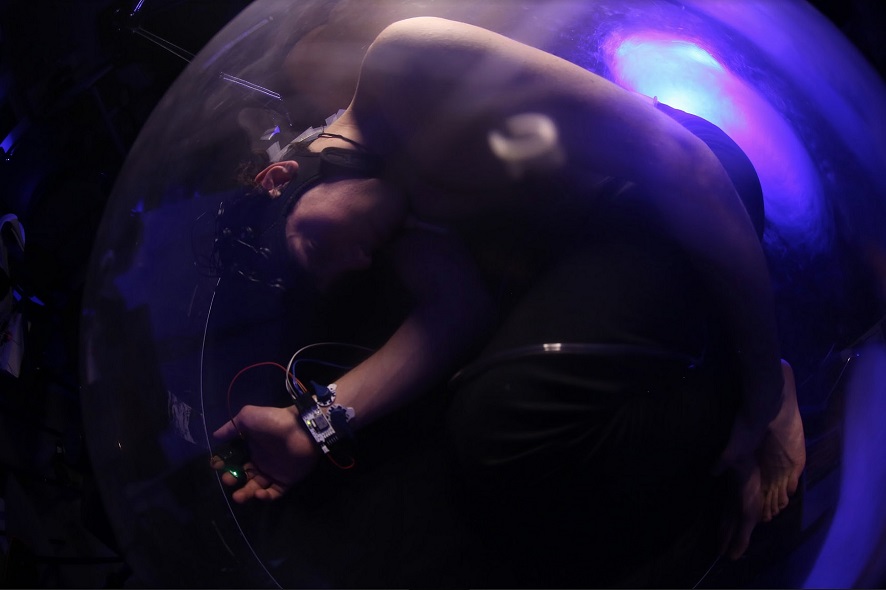What happens when art encounters science? Just about everything Ars Electronica does is an innovative response to this question! Because the connections between art and science deserve very special attention, this year’s edition of “The Practice of Art and Science” at the Ars Electronica Festival September 6-10, 2018 will showcase projects situated at this fascinating nexus.
“The Practice of Art and Science” brings together exemplary works with wide-ranging content by artists and scientists—fashion and modern technology, purely scientific research, art and space travel, and much, much more. Festival director Martin Honzik and producer Veronika Liebl gave us a preview in this interview.

The Kepler Station. Credit: Florian Voggeneder
What does “The Practice of Art and Science” have in store for festivalgoers this year?
Martin Honzik: Art and science is basically the meta-theme of Ars Electronica and is thus present in virtually all our projects, but we’re highlighting it once again this year at the Festival in a showcase consisting of diverse elements: an exhibition about the STARTS projects (Science, Technology and the ARTS, an initiative of the European Commission); a show featuring designers’ takes on art and science; and purely scientific R&D projects that are taking advantage of the festival to deliver a progress report to the general public. Once festivalgoers have successfully navigated through these three exhibits, they arrive at the Hackathon zone, where the g.tec medical engineering company is putting their brain-computer interfaces into the hands of some creative young people with a penchant for high-tech, and staging a hacking competition to demonstrate what this stuff is actually capable of. And right nearby in this section of POSTCITY is the Future Innovators Summit, a lively, creative, educational get-together.
Veronika Liebl: Heading to the left from the Infodesk, you’re immediately immersed in the STARTS area. You move on to Fashion and Art&Science, and then, after a sharp curve, you wind up in the Hackathon area. Then, veering off towards POSTCITY’s main exit brings you to Space Art.

SPHAERE. Credit: Gregor Göttfert, Florian Kofler
Art and science is actually the core theme of Ars Electronica. Why are you playing it up even more prominently in a special setting?
Martin Honzik: Because these are programs directly subsumed under this heading, and also because there are so many interesting things going on at the moment in the context of art and science that really do deserve special attention. They take the art-science interface to a new level. Here, art isn’t a decorative accessory to science—and it never was for us. Art exerts an influence on science, and is accepted by science as such.
Veronika Liebl: In this context, art makes it possible to blaze new trails and to take leave of old mental patterns. This is exactly what we’re after as we go about seeking social innovation. An essential reason why we want to highlight this connection on a special platform at the Ars Electronica Festival is the fact that we work closely together throughout the year with numerous institutions and organizations and we’d now like to present the results of these collaborative efforts. Here, we’re talking about universities like the MIT Media Lab, Austrian companies such as Greiner, Rosenbauer and g.tec medical engineering, as well as global institutions like the European Space Agency (ESA). These professional relationships are often outgrowths of interdisciplinary R&D joint ventures such as the projects subsidized by the European Commission’s Horizon 2020 research program: the STARTS Residencies and Wear Sustain. Both of them are situated at the interface of art and science, and will be exhibiting their latest prototypes and research results at the Festival.

Expanding Bodies in Expanded Realieties, Fashion & Technology. Credit: Julio Escudero
Could you cite a few examples?
Veronika Liebl: One highlight is definitely the Fashion area, where the first students to complete Linz Art University’s Fashion & Technology program will present their bachelor’s degree projects.
Martin Honzik: This is the first time that they’re showing their work in public. And this is the launch of large-scale cooperation over the next several years, when the program will offer a master’s degree and perhaps even a PhD.
Veronika Liebl: Another highlight in this connection is Wear Sustain. WEAR (Wearable Technologists Engage with Artists for Responsible Innovation) Sustain is a STARTS project financed by Horizon 2020, the European Commission’s research and innovation initiative to encourage the art, design and creative sector to work more closely together with high-tech machinery industries and to impart a more sustainable and more ethical orientation to the development of wearables and eTextiles. Their mission is to truly revolutionize this entire sector—from design to production to sustainable retailing. The immediate objective is to generate new models in this huge industry. In concrete terms, we’re talking about projects that emphasize data security as a part of a garment’s design, environmental aspects, integration issues and material innovations.
What’s happening in Space Art?
Martin Honzik: Space travel is a topic of tremendous relevance to us at Ars Electronica, also in the context of “The Practice of Art and Science.” We’ve been collaborating for quite some time now with the ESA and the European Southern Observatory, two very agile and cooperative partners in the European Digital Art & Science Network, one of the first art/science projects initiated by Ars Electronica and subsidized by the EU. And this program enabled us to establish ourselves as a European institution in the context of art and science. This cooperation as well as the technological influence and the philosophical challenge that outer space brings to bear in our worldview are things that we’d very much like to underscore this year. We’re bringing together in a single space artistic takes that show how outer space has become a part of our world. In fact, two of them are by Upper Austrian artists: “SPHERE” by Gregor Göttfert and Florian Kofler, and “The Kepler Station” by Florian Voggeneder. This exhibition also includes Miha Turšič’s “KOSMICA Parliament,” “The Contour of Presence” by Nahum, and a series of projects from the MIT Media Lab.

KOSMICA Parliament. Credit: Miha Turšič
Which projects in “The Practice of Art and Science” are purely of a scientific nature?
Martin Honzik: The ASSISIbf project is one of the most interesting in this field. It’s by an alliance of three university teams in Switzerland, Italy and Austria whose research background and objective is to compare forms of swarm intelligence found in nature with the network intelligence of neuronal networks, and to make them mutually useful. In concrete terms, they’re investigating the behavior of fish and bees. Is it possible on the basis of swarm intelligence to ascertain whether anomalies are present in nature—radical or sudden environmental changes, for instance? The aim is to raise human consciousness of our environment and to make the environment useful by showing how to recognize on the basis of changes in the behavior of bees and fish how severely animals—and human beings—are impacted by environmental pollution. This is an extremely clever approach.

aqua_forensic. Credit: Robertina Šebjanič, Gjino Šutić
The European Media Art Platform (EMAP) is on hand once again…
Veronika Liebl: This will be one of the absolute highlights! EMAP is one of the residency programs we’re currently involved in. It’s financed by the EU’s Creative Europe Program and enables Ars Electronica and 10 other European institutions including FACT, LABoral, Onassis Cultural Center, IMPAKT, Bandit-Mages and the WRO Center to give annual production grants to outstanding European media artists. Our 2018 recipients are artist Robertina Šebjanič and scientist Gjino Šutić, who analyze contaminants and residues in marine habitats. They conducted their project’s tests in the Danube and in Dubrovnik. In addition to their installation—which will be on display in the Bunker as part of the Error in Progress exhibition—we’ll be presenting five more projects that were brought to fruition during residencies.

Veronika Liebl is an assistant divisional manager at Ars Electronica. Her responsibilities include organizing and financing the Festival, Prix and exhibitions. She studied economics at Johannes Kepler University in Linz (graduated in 2010) with studies abroad at Harvard University (US) and the Université de Fribourg (CH). While employed full-time, she got her MBA in Innovation Management at LIMAK Linz – Austrian Business School in 2013. Since 2011, she has worked in culture management in Ars Electronica’s Festival, Prix and Exhibitions divisions. In this capacity, she has played a key role in the development in European cooperative projects and EU projects in conjunction with the Creative Europe, Horizon 2020 und Erasmus + programs.

Martin Honzik is an artist and director of Ars Electronica’s Festival, Prix and Exhibitions divisions. He studied visual experimental design at Linz Art University (graduated in 2001) and completed the master’s program in culture & media management at the University of Linz and ICCM Salzburg (graduated in 2003). In addition to his work as a freelance artist in various art projects, he was a member of the staff of the Ars Electronica Future Lab, where, until 2005, his responsibilities included exhibition design, art in architecture, interface design, event design and project management. Since 2006, Martin Honzik has been director of the Ars Electronica Festival and the Prix Ars Electronica and in charge of exhibitions in the Ars Electronica Center as well as Ars Electronica’s international exhibition projects.
“The Practice of Art and Science” will be on display on the Upper Level of POSTCITY Linz throughout the Ars Electronica Festival September 6-10, 2018 during regular festival hours. Complete details are available on our website.
To learn more about Ars Electronica, follow us on Facebook, Twitter, Instagram et al., subscribe to our newsletter, and check us out online at https://ars.electronica.art/news/en/.
